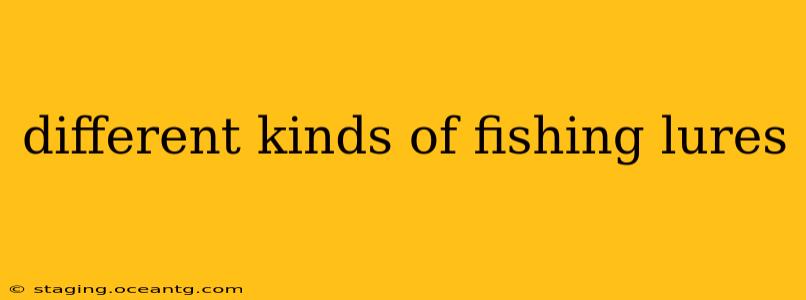Fishing lures are artificial bait designed to attract and catch fish. The vast array of lures available can seem overwhelming to beginners, but understanding the different types and their applications can significantly improve your fishing success. This guide explores various fishing lure categories, explaining their design, function, and ideal fishing situations.
What are the Most Common Types of Fishing Lures?
This is a broad question, as the sheer number of lure types is extensive. However, we can categorize them into several key groups based on their action and design:
1. Spoons
Spoons are metal lures that create a shimmering, flashing action in the water, mimicking the movement of baitfish. Their design, often a curved, spoon-shaped piece of metal, causes them to wobble and flash as they are retrieved. Spoons are effective for a wide variety of fish species and are particularly good for trolling or casting in deeper water. They come in various sizes, weights, and finishes to suit different fishing conditions.
2. Spinnerbaits
Spinnerbaits consist of a weighted jig head with one or more spinning blades. The spinning blades create vibrations and flash, attracting fish from a distance. They're highly versatile and can be fished in various ways, from slow rolling to fast retrieves, making them effective in different water depths and conditions. The blades can be different sizes and colors, further customizing their appeal.
3. Crankbaits
Crankbaits are hard-bodied lures designed to run at various depths depending on their lip design. The lip creates resistance in the water, causing the lure to dive to a specific depth. They are effective for targeting fish holding at different depths and often feature realistic paint jobs and internal rattles to enhance their appeal. Crankbaits are incredibly diverse, with countless variations in size, shape, running depth, and action.
4. Topwater Lures
Topwater lures are designed to float on the surface of the water. These lures often have unique actions, like walking the dog (a side-to-side movement), popping, or chugging, creating disturbances on the water’s surface that attract predatory fish. These lures are particularly effective during low-light conditions or when fish are feeding near the surface. Examples include poppers, buzzbaits, and prop baits.
5. Jigs
Jigs are weighted hooks with a variety of skirts, bodies, or trailers. They can be fished near the bottom, bounced along the bottom, or hopped to create an enticing action. Jigs are extremely versatile, with different variations targeting different fish species and water conditions. The weight of the jig, the type of skirt or body material, and the hook size all play a role in its effectiveness.
What are the Different Types of Fishing Lure Actions?
The action of a lure refers to how it moves through the water. Understanding lure action is crucial for selecting the right lure for a specific situation. Different actions trigger different predatory responses in fish. Here are some common lure actions:
- Wobbling: A side-to-side movement.
- Rolling: A rotating movement.
- Swimming: A straight, consistent movement.
- Jerking: A quick, erratic movement.
- Walking the dog: A side-to-side movement on the surface.
What are Some Popular Fishing Lure Brands?
Many reputable brands manufacture fishing lures, each with its own strengths and specialties. The best brand for you will depend on your fishing style and preferences. Some of the most well-known brands include Rapala, Mepps, Strike King, Lucky Craft, and Yum.
How Do I Choose the Right Fishing Lure?
Choosing the right lure involves considering several factors:
- Target Species: Different fish species prefer different types of lures.
- Water Conditions: Clear water may call for more subtle lures, while murky water may benefit from louder lures.
- Water Depth: Different lures are designed to run at different depths.
- Retrieve Speed: The speed at which you retrieve the lure can affect its action and its effectiveness.
Experimentation is key! Trying different lures in different situations is the best way to learn what works best for you.
This comprehensive guide provides a solid foundation in understanding the diverse world of fishing lures. Remember, the best lure is the one that catches fish! Happy fishing!
